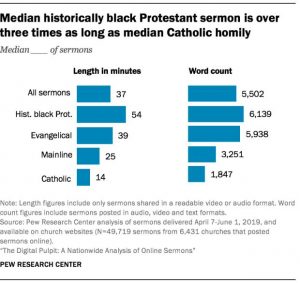
A study by the Pew Research Center finds striking differences in the length and content of American sermons according to their Christian traditions. The study used computational tools to identify church in the Google Places application programming interface (API) and then collected, transcribed, and analyzed the sermons publicly posted on a representative sample of  their websites during an eight-week period. The median sermon taken from congregational websites is 37 minutes long, with Catholic sermons being the briefest (at a median of just 14 minutes), compared with 25 minutes for sermons in mainline Protestant congregations and 39 minutes in evangelical Protestant congregations. The longest sermons were by far found in historically black Protestant churches, coming in at 54 minutes. Clergy across all major Christian traditions, are more likely to refer to books from the New Testament (90 percent do) than the Old Testament (61 percent). This pattern of citing the New Testament is especially pronounced in mainline Protestant and Catholic sermons. This may be due to Protestant and Catholic clergy preaching on the day’s Gospel reading from the lectionary. The analysis also picked up on the distinctive vocabulary in each Christian tradition. While the word “hallelujah” is not unique to historically black Protestant services, the usage of it was a hallmark of black Protestant sermons. Catholic sermons tended to include the words “diocese” and “Eucharist.” The three terms most disproportionately used in evangelical sermons include variants of the phrases “eternal hell,” “lose … salvation,” and “trespass … sin.”
their websites during an eight-week period. The median sermon taken from congregational websites is 37 minutes long, with Catholic sermons being the briefest (at a median of just 14 minutes), compared with 25 minutes for sermons in mainline Protestant congregations and 39 minutes in evangelical Protestant congregations. The longest sermons were by far found in historically black Protestant churches, coming in at 54 minutes. Clergy across all major Christian traditions, are more likely to refer to books from the New Testament (90 percent do) than the Old Testament (61 percent). This pattern of citing the New Testament is especially pronounced in mainline Protestant and Catholic sermons. This may be due to Protestant and Catholic clergy preaching on the day’s Gospel reading from the lectionary. The analysis also picked up on the distinctive vocabulary in each Christian tradition. While the word “hallelujah” is not unique to historically black Protestant services, the usage of it was a hallmark of black Protestant sermons. Catholic sermons tended to include the words “diocese” and “Eucharist.” The three terms most disproportionately used in evangelical sermons include variants of the phrases “eternal hell,” “lose … salvation,” and “trespass … sin.”
(The Pew report can be downloaded here)
British television shows are portraying clergy and religion in a more favorable light than was the case two decades ago, although these depictions may also signal continuing secularization in Britain.  A study, conducted by Andrew Crome of Manchester Metropolitan University and published in the online journal Religions (11,38), looked at recent television shows with clergy as central characters and how that shows what has been called the “new visibility of religion” thesis taking shape in secular Western societies. The shows, running between 2009 and 2019, are Fleabag, Broadchurch, Broken, and Rev., and are compared with shows in the 1980s and 1990s, which tended to have a more negative depictions of clergy. Such shows as Broken, portray the way priests served the working class in ways that other people could not, even using imagery of the Eucharist to portray their sacrifice. The creators of Rev. show God’s intervention through the sacraments and in everyday life, and even the irreverent sexual humor of Fleabag shows the power of the priest’s vocation as he is unable to leave the priesthood. But while these shows do suggest a new visibility of religion in the media, Crome cautions that they assume a secularized society where religion is seen as exotic and performing a certain social function (such as in inner city ministry) but losing relevance for most people.
A study, conducted by Andrew Crome of Manchester Metropolitan University and published in the online journal Religions (11,38), looked at recent television shows with clergy as central characters and how that shows what has been called the “new visibility of religion” thesis taking shape in secular Western societies. The shows, running between 2009 and 2019, are Fleabag, Broadchurch, Broken, and Rev., and are compared with shows in the 1980s and 1990s, which tended to have a more negative depictions of clergy. Such shows as Broken, portray the way priests served the working class in ways that other people could not, even using imagery of the Eucharist to portray their sacrifice. The creators of Rev. show God’s intervention through the sacraments and in everyday life, and even the irreverent sexual humor of Fleabag shows the power of the priest’s vocation as he is unable to leave the priesthood. But while these shows do suggest a new visibility of religion in the media, Crome cautions that they assume a secularized society where religion is seen as exotic and performing a certain social function (such as in inner city ministry) but losing relevance for most people.
(Religions, https://www.mdpi.com/2077-1444/11/1/38)